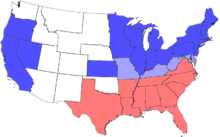The Confederate and the Union both had strengths and weaknesses. The Confederate had much better generals who could fight and liked to fight. The Union generals did not like to fight and didn't take the war very seriously in the beginning. The Confederate had the advantage of fighting on their own land so they were not worried about gaining land unlike the Union. The South depended on the North for their every day things so when they were fighting they were cut off from them. The Union had twice as many men so they had a big advantage because they had more men to fight. There was better transportation in the north so they could transport goods and people. The first battle of the Civil War was Fort Sumpter or Sumter off the coast of Charleston, South Carolina. Lincoln gave South Carolina a choice to either wait to shoot or go ahead and fire. When they attacked on April 12,1861, the war began. After two days of fighting, Fort Sumpter was taken by the northern states. The next battle was Bull Run or Manassas at Bull Run Creek. The Union troops attacked The Confederate troops where they were stationed but the Union didn't take the battle very seriously because northerners went with picnic baskets to watch the fighting. During the fighting The Union troops had killed most of the Confederate troops but when they thought it was over Stonewall Jackson's reinforcement troops came. That was when The Union realized the war was going to take more effort, time and money than they thought. September 17,1862 the battle of Antietam or Sharpsburg took place. It was the bloodiest single-day battle however there was no official winner. In 1862, The Union only won two of the battles they fought so because the Union did not technically loose the battle, Lincoln considered it a win and put the Emancipation Proclamation into effect.

This is a picture of the battle of Antietam since it lasted only one day and it was the bloodiest battle.
http://www.google.com/url?sa=i&rct=j&q=&esrc=s&frm=1&source=images&cd=&cad=rja&docid=UCgfEjMq3-qi-M&tbnid=3q5ImzIly4lumM:&ved=0CAUQjRw&url=http%3A%2F%2Fwww.jenjdanna.com%2Fblog%2F2012%2F2%2F21%2Fforensic-case-files-147-years-after-the-battle-of-antietam-a.html&ei=jpLdUvHTNoi6kQfit4DoBw&psig=AFQjCNGPnxCz9qJzrsBtGcp2x3TzX02Mfg&ust=1390338839859382






